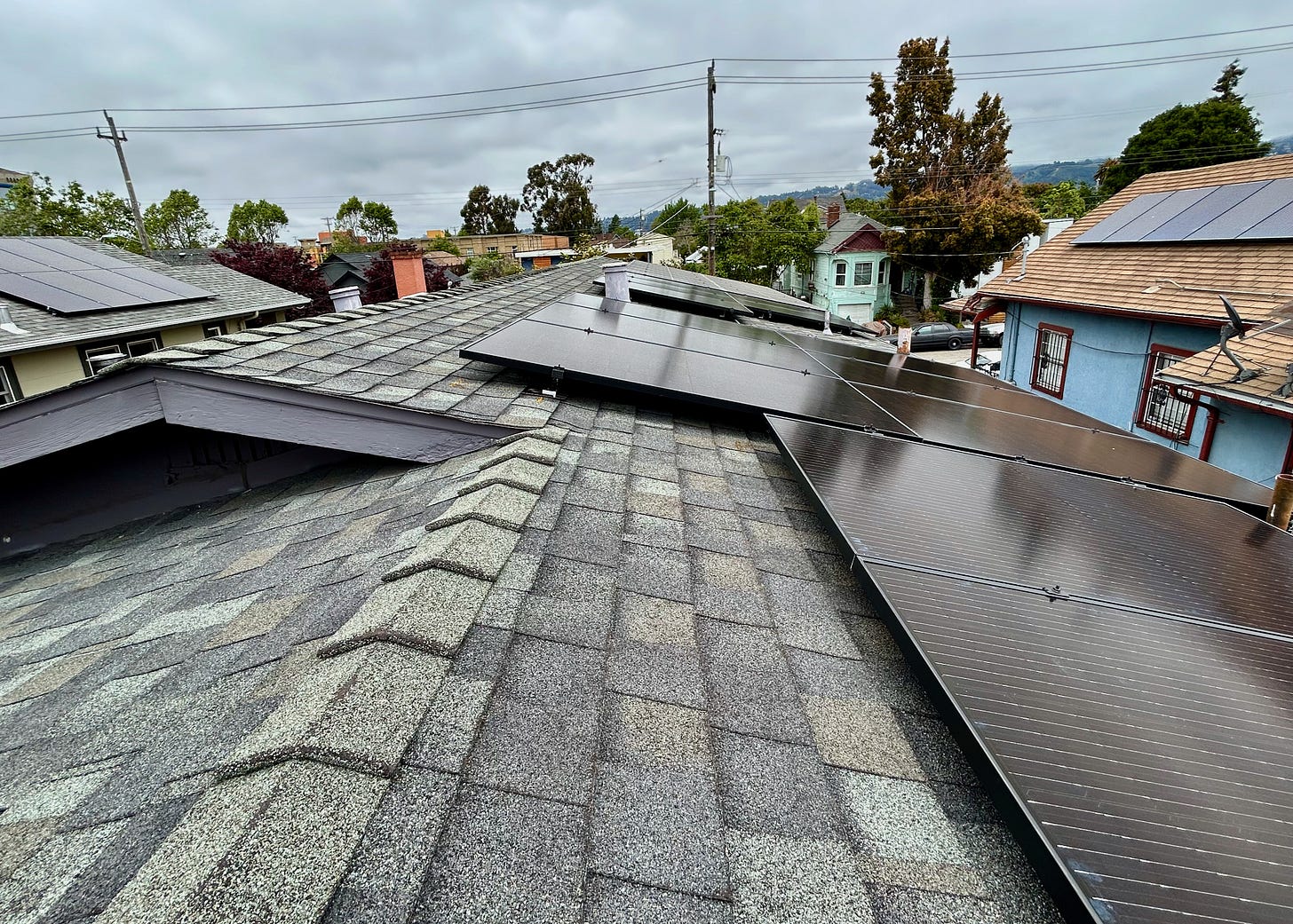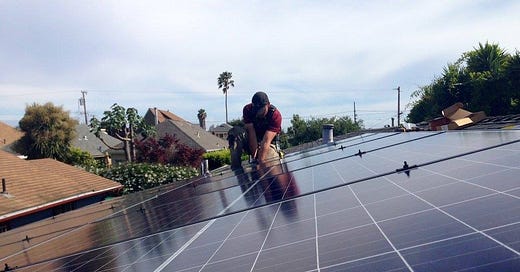
What did you do last weekend? We had solar panels installed!
I’d say I was interrupting my regularly scheduled programming with this post, but by now you probably know there’s nothing regular about this newsletter. The one constant to all the topics I cover is that they’re written from my Flower Child perspective, as someone who grew up in the 1960s and ‘70s and absorbed the zeitgeist of those decades.
One of the values instilled in me then was environmentalism, something I aspire to but sometimes fall short of in my own life. Though I did leave a much more lucrative tech career to work in clean energy, so there’s that.
And that brings me back to the theme that kicked off my newsletter, when Rafael and I embarked on our EV road trip last fall. Documenting that journey was the catalyst that got me writing regularly.
But the trip in our new (used) EV was just one part of our larger electrification journey. For those of you who are not following the electrification trend, it’s a big one — and it’s critical. To fight climate change, we need to switch to clean energy, and we also need to electrify everything so we run everything on clean electricity. Those aren’t the only climate actions we need to take, but they’re foundational and non-negotiable.
Rafael and I are trying to do our part while also hedging against rising energy prices. In 2016, a year after we moved from a condo in San Francisco (where we didn’t manage to go solar, despite our best efforts) to a house in Oakland, we had 12 solar panels installed on our roof.
They’ve been working fine, other than on those apocalyptic wildfire days we experienced a few years ago. But our needs have changed. We added some electric load by finishing our partial basement to serve as Rafael’s home office, aka The Lair. We both began working from home full-time, even before covid. Then there was the EV. Early this year, we continued our electrification journey with a new induction cooktop.
The bigger items are still to come. To get completely off fossil gas (nothing natural about it, so let’s call it what it is!), we’ll need to switch to a heat pump heater and a heat pump water heater. Apart from being much more efficient than our old furnace and running on electricity, the heat pump heater will have the benefit of being able to run in reverse as an air conditioner, which will be welcome as summers keep getting hotter.
To power all those items, we realized we’d need more solar panels. We had to act fast, because of a misguided decision by the California Public Utilities Commission to lower the net metering (NEM) credit, referred to as NEM 3.0 because it’s California’s third version of the system. Net metering basically allows you to use the power grid as a battery: your solar panels generate electricity during the day, when you’re using less power, and then at night, when you need it the most, you can use the credit from the power your panels have fed into the grid.

If you want to read more about NEM 3.0 and how it will put a damper on California’s thriving solar market, check out this article series, this article, and this message (to dig in more on NEM in general, see my articles about the benefits of NEM, the many NEM studies, and the real cost shift that’s burdening utility customers).
Needless to say, solar companies in the state were flooded with potential customers trying to sign up for solar before NEM 3.0 kicked in, and we were among them.

We got in just in time, but others won’t be so lucky. Under NEM 3.0, the credit for solar sent back to the grid will be 75% lower. Rooftop solar will once again be out of reach for many in California.
The proposed solution, batteries, won’t help most people. If you store the energy you produce in batteries, it doesn’t matter how much credit the utility gives you for energy sent back to the grid, because you’re storing it instead of sending it back. But batteries are still expensive, and it takes a lot of battery power to run a whole house. Rafael and I don’t have the extra motivation of frequent power outages, another way in which we’re lucky (for now). I’d love to get a battery someday, but we’ll have to wait for prices to come down.
Speaking of batteries: If you want to go solar and electrify but are worried about not being able to cook during power outages, some new induction stoves will include built-in batteries. We opted not to wait for those.
Thanks to the Inflation Reduction Act, we’ll get the same 30% tax credit for our panels that we got in 2016. And with an 8 kW system on our roof, we’ll now have enough solar to support all our electricity needs. In addition to the money we’ve spent on solar, we’ll spend some money on the heat pumps (offset by some new incentives), but we’ll keep our power bills low and stable. You can’t completely get rid of your power bill, because there’s a charge for being connected to the grid.
Wondering what it takes to go solar in California or elsewhere? Thinking about electrifying? Here are some resources to help:
This post covers what you need to know about solar. Some of it is California-centric, but the general information applies in much of the U.S.
Rewiring America’s Inflation Reduction Act calculator lets you see which federal incentives you might qualify for. They’ve also written an electrification guide.
You may also qualify for local incentives from organizations like BayREN, a Bay Area partnership of local governments.
The Building Decarbonization Coalition is a good source for electrification initiatives and resources.
The QuitCarbon concierge service helps you create and implement an electrification plan, at no cost to you. We’re trying it out, and they’ve already been helpful.
This is the fifth in my electrification and renewables series. Previous posts:
Do you have any tips or questions on solar and electrification? Let me know in the comments!



